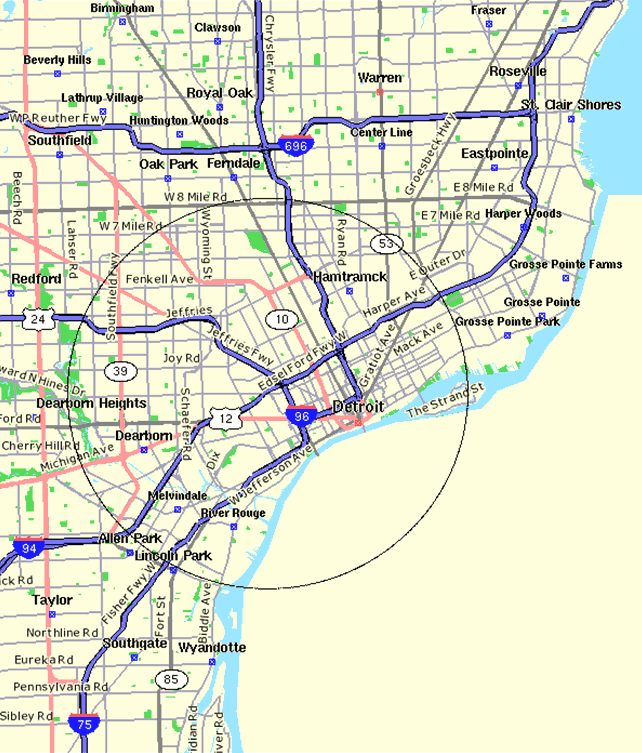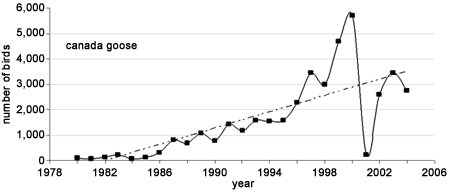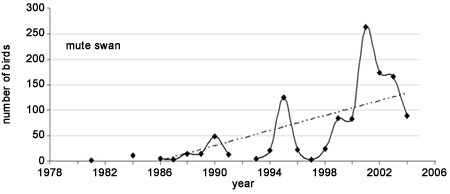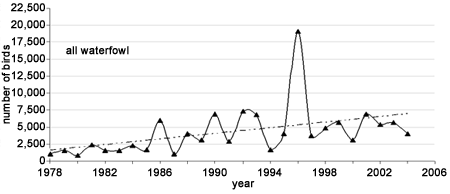Detroit River-Western Lake Erie Basin Indicator Project
Detroit River Christmas Bird Count
Background
The Christmas Bird Count tradition began Christmas Day, 1900, led by ornithologist Frank Chapman, an early officer for the Audubon Society. This count was proposed as a new holiday tradition, a "Christmas Bird Census", rather then a Christmas hunt which was a tradition in the past. During the first count in 1900, there were 27 participants (Audubon 2005). In 2005 that number grew to over 50,000 participants in over 2,000 locations nationwide. Over the years these volunteer efforts have been compiled into the longest running database in ornithology, representing over a century of unbroken data on trends of early-winter bird populations across the Americas (Audubon 2005).
The Detroit River annual Christmas Bird Count (CBC) was established in 1978 as a binational endeavor to count overwintering birds. The area covered is a circle centered on Detroit, encompassing parts of both Wayne County in Michigan and Essex County in Windsor (Figure 1). The count circle consists of mostly industrial, urban, and residential areas, but includes some natural areas, such as the Ojibway Prairie in Windsor and wetlands along the Detroit River that are critical for bird populations.

×
![]()
Figure 1. Map of the annual Detroit River Christmas bird count circle (click the map for a larger version).
CBC data are a one-day snapshot of the status and distribution of early winter bird populations recorded on December 14th through January 5th nationwide. An individual count, such as this one with a long history, is vital for conservation. These population data can act as indicators of habitat change in a count area by examining trends for certain species or suites of species that depend on specific habitats. Also, local trends in bird populations can signal an immediate environmental threat, such as groundwater contamination or poisoning from improper use of pesticides (Audubon 2005). These long-term data can also monitor the appearance or presence and increase in introduced species, which often have profound impacts on ecosystem health.
Status and Trends
Because these CBC count data are considered a one-day annual snapshot of the species population they do not necessarily correlate with population status. Though it seems possible to evaluate population changes from these trend lines, caution must be taken because there are annual changes in count effort, varying degrees of skill and diligence of observers, and biases in habitat coverage. The data are not corrected for these variations in observation frequency, observer skill level, or weather conditions.
There have been 35 species consistently counted on all 27 annual Detroit River CBC counts. One of those species is the canada goose. There are two different populations of canada geese in southeastern Michigan and southwestern Ontario, the migratory Branta canadensis interior and the resident Branta canadensis maxima. Prior to re-introduction efforts in Michigan and Canada in the 1920s and 1930s, the resident population was not present in the region. The population of Michigan's giant canada goose, B.c. maxima, has grown 14% annually, and continues to increase (MDNR 2001) (Figure 2). In 2001, the CBC count of canada geese was the lowest since 1981 due to the fact that the majority of water bodies were frozen over.

Figure 2. Canada goose Christmas Bird Count trend, 1980-2004.
Mute swans are a nonnative, invasive species introduced from north-central Asia and Europe. They are distinguishable from North American swans by the characteristic black knob at the base of their orange beak with a black tip. Mute swans spread throughout the United States from 1920 and in the late 1970s they were reported in all four flyways. In addition to being a nuisance to humans, they are ecologically damaging. They displace native waterfowl by taking over preferred nesting habitat and can seriously damage beds of submerged vegetation, critical to other waterfowl, by their heavy foraging. Mute swan numbers during the CBC fluctuate, but a steadily increasing trend is evident from 1986 through 2004 (Figure 3). Much of the variability in the data relates to the ability of observers to count the swans from land, which in turn depends on the extent of ice on the water.

Figure 3. Mute swan Christmas Bird Count trend, 1981, 1984, 1986-2004.
Waterfowl as a group also showed a general increasing trend from the late 1970s through 2004 (Figure 4). This yearly count includes waterfowl along the Rouge River as well as parts of the Detroit River. Waterfowl counts vary each year depending on the amount of frozen water; a high percentage of frozen water correlates with a low waterfowl count.

Figure 4. All waterfowl Christmas Bird Count trend, 1978-2004.
Management Next Steps
It is recommended that management activities continue to monitor mute swan populations and initiate control measures, as necessary. In addition, conservation and restoration of critical waterfowl habitats should be undertaken as a priority.
Research/Monitoring Needs
The annual Detroit River Christmas Bird Count should continue. In the future, yearly counts need to consistently cover the same areas, with the same amount of count hours by volunteers. An increase in volunteer education and participation would be valuable. Research should also be conducted on the environmental effects of the invasive Mute Swan and methods to control the population.
References
- Audubon. 2005. The 106th CBC, December 14th 2005 to January 5th 2006, History and Objectives. (March 2006). exit EPA
- Craves, J.A. and J.A. Fowler Jr. 2003. Twenty-five Years of the Detroit River (Michigan-Ontario) Christmas Bird Count. Ontario Birds December 2003. 21(3) :110-128.
- Michigan Department of Natural Resources. 2001. Waterfowl Status. (December 2002).
Contact Information regarding Detroit River Christmas Bird Count
Julie A. Craves
Rouge River Bird ObservatoryUniversity of Michigan-Dearborn
E-mail: jcraves@umd.umich.edu